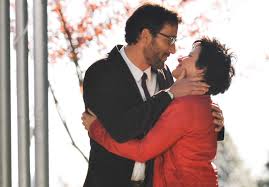Words and Pictures
Posted on June 5, 2014 at 6:00 pm
 What a refreshing change to have a witty grown-up love story in the midst of summer movie season. Popping up in the middle of monsters, superheroes, and special effects is this endearing romance built around what Shakespeare (and George Orwell) called “a merry war” between two teachers that challenges the darker wars each is fighting with themselves.
What a refreshing change to have a witty grown-up love story in the midst of summer movie season. Popping up in the middle of monsters, superheroes, and special effects is this endearing romance built around what Shakespeare (and George Orwell) called “a merry war” between two teachers that challenges the darker wars each is fighting with themselves.
Jack Marcus (Clive Owen) teaches English at a prep school, very popular with his students and very good at getting the best from them. Once a promising poet, he has been unable to make any progress on a new book and his relationships in the community, with the school administration, and with his son are deteriorating due to his abuse of alcohol. The prestige he had as a writer “made it easier to forgive faults,” a school board member warns him. His sense of himself as a good teacher is what fuels his denial about his failures in other parts of his life, and keeps him feeling superior. He likes to challenge the other faculty members to word games, especially one involving coming up with five-syllable words for each letter in the alphabet.
A new teacher arrives. Her name is Dina Delsanto (Juliette Binoche) and like Jack, she is respected for her work outside the classroom as a gallery artist. (The paintings in the film were created by Binoche herself, who is an accomplished artist.) When she says she teaches art, Jack comments, “Hence the scarf.” When he tells her he teaches literature, she responds, “Hence the ‘hence.'” He feels awake for the first time in many years because like Ferdinand in Shakespeare’s “Tempest,” he has found someone who speaks his language. Jack talks too much. Dina talks too little, especially when it comes for the reason she is teaching and the reason she left New York and the reason she uses a cane, all of which are the same reason.
Or has he? He challenges Dina with a five-syllable “a” word: antihistamine. She responds “blahblahblahblah,” which, as he points out, is just four syllables, and, as he does not point out because he is intrigued by her, it is not a word. Dina believes that pictures are not just worth a thousand words, they are truer, too. They conduct a “merry war” between words and pictures because first, it captivates the students, and that matters to both of them more than they admit to themselves, and second, like the five-syllable word challenge, it gives them a witty context to explore some romantic feelings without getting too sentimental. It can be arch and artificial, but it is smart and funny and Owen and Binoche are clearly enjoying themselves and we enjoy it, too.
Parents should know that this film includes strong language, some crude, sexual references and a sexual situation, painful family confrontations, illness, and some mild peril.
Family discussion: Which do you prefer, words or pictures, and why? How should the school handle a problem like the one faced by Emily? What makes a great teacher?
If you like this, try: “Roxanne,” by the same director and “Dan in Real Life” with Juliette Binoche
